As I prepare a special version of the Weekly Metagame series dedicated to Modern Horizons II, the need for an article to talk exclusively about Standard and Historic has become increasingly apparent, as the formats played a leading role in one of the most important events of the year for Competitive Magic: The Strixhaven Championship.
Within so much controversy about the event, and especially about the Historic portion, it became relevant to have an exclusive article to debate the event and especially the future of Historic after so much debate this weekend.
Ad
It is important to mention that the Metagame of a tournament like the Strixhaven Championship is more complicated to evaluate or predict based on the Top 8 because it is an event with two distinct formats being played and disputed for the position in the Top 8.
Therefore, it is possible for a player to have an average or poor result in one format while having an exceptional result in the other and thus qualify for the Top 8.
In this article, I'll try to assess how the decks fared in the event and which decks stood out, as well as debating a little about the future of both formats.
Standard
The Standard Metagame was composed by the following decks:
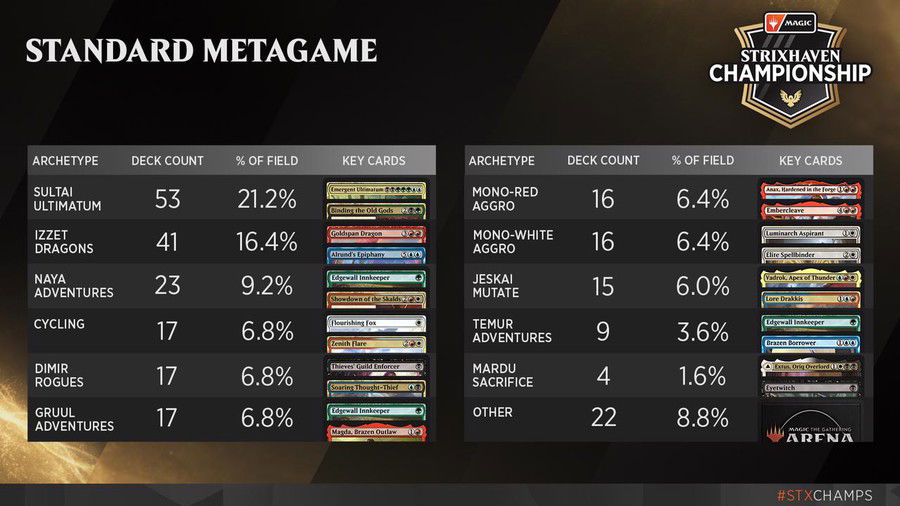
It is important, to assess the performance of decks, to have as much information as possible to make the best analysis as we can. So let's start with converting the decks based on the winrate and the number of decks that managed to score 6-2 or better.
The only deck that made 8-0 was Seth Manfield's Izzet Dragons.
The decks that made 7-1 had the following archetypes:
1 Naya Adventures
1 Jeskai Cycling
1 Temur Adventures
1 Sultai Ultimatum
And the decks that made 6-2 in the tournament were:
4 Sultai Ultimatum
4 Izzet Dragons
3 Dimir Rogues
2 Jeskai Mutate
2 Mono-White Aggro
1 Temur Adventures
1 Naya Adventures
1 Gruul Adventures
1 Mono-Red Aggro
1 Jeskai Cycling
1 Four-Color Blink
So we had the following archetypes with a result of 6-2 or better:
5 Sultai Ultimatum
5 Izzet Dragons
3 Dimir Rogues
2 Jeskai Mutate
2 Temur Adventures
2 Naya Adventures
2 Jeskai Cycling
2 Mono-White Aggro
1 Gruul Adventures
1 Mono-Red Aggro
1 Four-Color Blink
From these results, what can we conclude?
• Sultai Ultimatum and Izzet Dragons are indeed the best decks of the format.
• Aggro decks that prey on Sultai Ultimatum performed averagely.
• Adventure decks remain a solid option for the format.
• Rogues may not have placed any players in the Top 8, but it did get a good overall result.
• Jeskai Mutate, which until last week looked like a meme deck, performed well in the event, which can be attributed to the fact that most players didn't know exactly how to play against it.
In terms of conversion, I believe that for the most part we had the expected results:
• Sultai Ultimatum had a conversion of around 9.5% (5 of 53), while Izzet Dragons had a relatively better conversion of 12.5% (5 of 41). This is probably because Izzet Dragons commonly prey on decks that tend to have a favorable matchup against Sultai Ultimatum.
• The other decks performed as expected, but we can highlight Temur Adventures, with a 22% conversion (2 out of 9).
As the highlight of the week was Jeskai Mutate, I think it's important to talk a little about this deck:
How exactly does this deck work, since many players apparently had no idea how to play against it?
Your goal is to make your creatures Mutate into Goldspan Dragon, which will create treasures and return spells from your graveyard that will create more treasures, and draw cards like Seize the Spoils and Prismari Command to fetch more creatures with Mutate that will return spells from your graveyard to your hand with Lore Drakkis or can be cast for free with Valdrok, Apex of Thunder, turning Goldspan Dragon into some kind of Krark-Clan Ironworks with the treasures it creates.
Ad
This can even be taken to levels of loops that last longer than ten minutes, using Unsubstantiate to return your creatures or spells to the hand, and you can repeat the process of “enchanting” Goldspan Dragon with Mutate creatures over and over again, creating more treasures, drawing more cards, etc.
Now check out this winrate sheet made by MTGData:
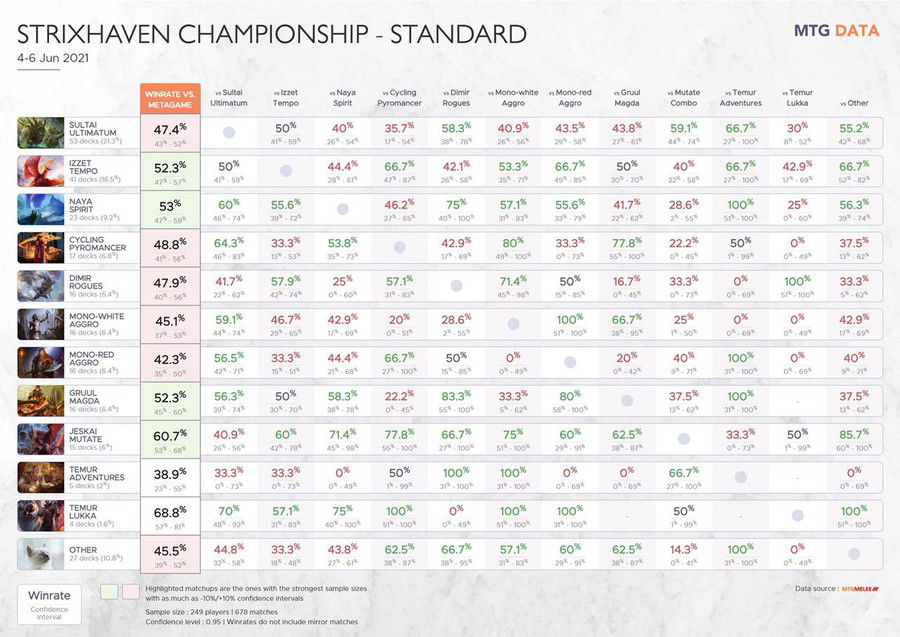
In terms of Winrate, Jeskai Mutate was second only to Temur Lukka, which had significantly fewer decks in the event.
Its negative matchups boiled down to a slightly bad match against Sultai Ultimatum and horrendous against Temur Adventures, while it had a relatively good match against everything else, so I see it as the big highlight of this event.
As such, I believe Standard's Metagame will proceed as follows in the coming weeks:
• Sultai Ultimatum and Izzet Dragons are the best decks of the format, with possibly Izzet Dragons having a slight advantage over other decks.
• Adventures remains a viable strategy and each variant has its pros and cons, it's up to the player to decide which version is best for each event, but Naya and Lukka versions seem to have a balanced match against the best decks of the format.
• Temur Lukka showed great potential at this event, let's just see if those numbers will continue to be present in the coming weeks.
• Aggro still remains a good option while Emergent Ultimatum is among the top decks, but they suffer a lot against the Izzet Dragons and will become less relevant while the deck is at the top.
• Jeskai Mutate did very well in the event and probably more people will play it, however it is not an easy deck to pilot and more players will also respect it and I expect it will eventually be hated out of the format.
• Cycling and Rogues will remain popular as affordable and popular Magic Arena options that can pull in good results, with Rogues being a better deck against the Izzet Dragons while Cycling is a better deck against the Sultai Ultimatum.
In summary, I don't think anything will change too much until the release of Adventures in the Forgotten Realms, and in a general context, after months of much controversy, I can finally say that Standard is in a healthy and diverse state.
Unfortunately, I don't think we can say the same about Historic.
Historic
The Historic portion of the event had the following Metagame:
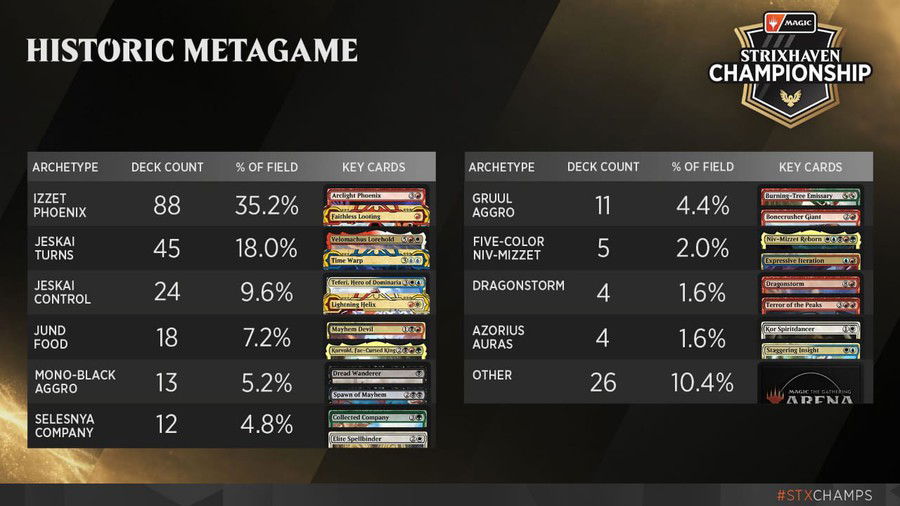
Considering all the list that had a result of 5-2 or more, we have:
Matt Nass's Jeskai Turns and Noah Ma's Jeskai Control were the only decks that had a 7-0 result.
On the 6-1 decks, we have:
7 Jeskai Turns
4 Izzet Phoenix
1 Five-Color Niv-Mizzet
1 Jeskai Control
1 Selesnya Company
And on the 5-2 decks, we also have:
15 Izzet Phoenix
7 Jeskai Turns
4 Jeskai Control
1 Five-Color Niv-Mizzet
1 Jund Food
1 Temur Ramp
1 Temur Marvel
1 Grixis Control
So, considering all decks that made 5-2 or better in swiss rounds, we have:
19 Izzet Phoenix
Ad
15 Jeskai Turns
6 Jeskai Control
2 Five-Color Niv-Mizzet
1 Selesnya Company
1 Jund Food
1 Grixis Control
1 Temur Ramp
1 Temur Marvel
If you compare it to the Standard numbers, you can see a big difference between the decks. But what can we conclude from these numbers?
• There is a clear discrepancy in results between the URx decks and the other decks in the format. This is proven by the fact that, among the most represented decks both in the Metagame and in the number of victories, they have a total of 40 of the 47 decks that achieved 5-2 or a better result.
• In terms of conversion, Jeskai Turns fared significantly better than Izzet Phoenix, with 33.3% (15 copies of 45) against 21.5% for Phoenix (19 copies of 88)
• In this same proportion, Jeskai Control had a good conversion, with 25% (6 of 24), as did the Five-Color Niv-Mizzet, with 40% (2 of 5)
• Except for some punctual lists like the Temur Marvel from Autumn Burchett, the other decks of the format had a bad or terrible performance.
• Tainted Pact is no longer a competitively viable archetype, and the two players who signed up with the deck had terrible results.
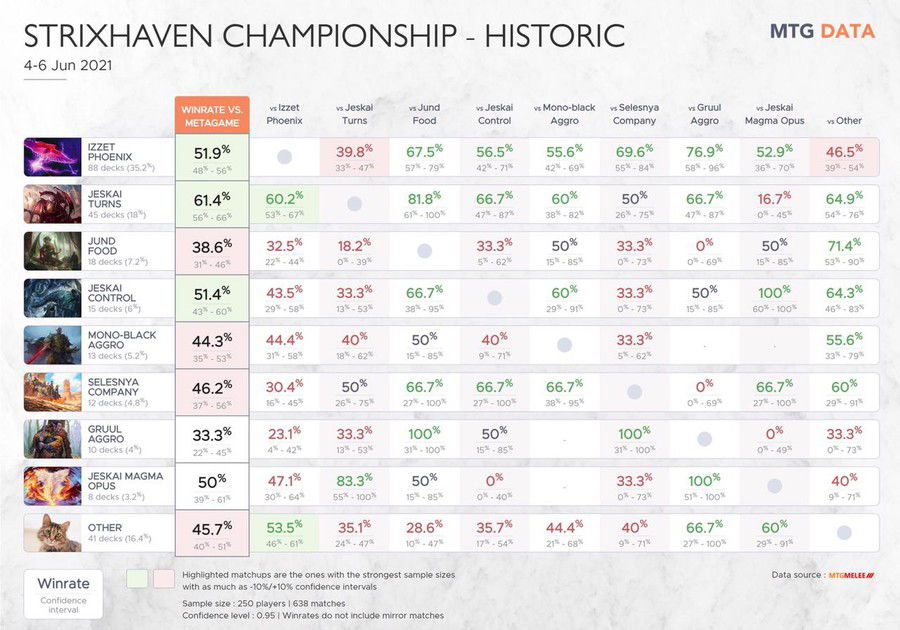
(Again, thanks MTGData, you guys are great!)
Looking at matches, most of the above statements hold, with the URx decks being the only ones among the top decks in the format with a significantly positive winrate against the rest of the Metagame.
And given this information, we can interpret the Historic case in two ways:
The first is to believe that Metagame was not prepared to handle these decks well, and they preyed on the tournament. It wouldn't be the first time a professional-sized event is dominated by a deck because players haven't prepared enough to play against it, we've seen this happen countless times in the history of Pro Tours, GPs, MagicFests, and more.
This theory is particularly acceptable when we talk about Jeskai Turns. Many players did not put so much faith in the archetype and some were even surprised with the deck being the second most played in the Metagame, being even ahead of the then most famous and with better results Jeskai Control.
On the other hand, the same can't be said about Izzet Phoenix, which everyone knew was the best deck in the format and that everyone needed to be ready to face it.
However, as the conversion of Izzet Phoenix is lower than that of Jeskai Turns and given the percentage of the deck's presence in the Metagame, in addition to the fact that it had a negative matchup against Jeskai Turns itself and other less played decks of the format (like Temur Marvel and Niv-Mizzet), I believe its numbers may be in the expected pattern.
Therefore, the conclusion of this line of reasoning is that the format is in an acceptable state, the Strixhaven Championship was an anomaly when it comes to Jeskai Turns, and Izzet Phoenix is, despite the best deck in the format, a healthy deck with healthy numbers.
But the other and most unpleasant way to look at it is that, honestly, Historic is a chaotic format, with little to no plannings, and possibly adding Mystical Archives cards was a bad idea for the format because they simply placed the cards There under a promissory note to make quick and assertive decisions should any deck become oppressive.
Ad
Personally, I really like the power level pump that the Mystical Archives brought to Historic, mainly because it turned it into a format more focused on impactful spells and not on constant board advantage.
Before Strixhaven, the format was dictated by creatures and was in a situation where you had Jund Food and Jund Sacrifice as the best decks because they held the main decks of the format, which were mostly Company decks and/or creature-oriented decks.
In my particular view, decks like Jund Sacrifice are bad better decks because they create a play style with repetitive patterns (sacrificing the cat to the oven, sacrificing the food, bringing the cat back, Mayhem Devil trigger, damage to you, cat trigger, damage to you, repeat process) that simply cannot be shortened and are not fun to watch while playing against or while watching a stream.
It's even important to point out that it was precisely this sequence that led to Cauldron Familiar being banned from Standard (and no, I'm not asking for Cauldron Familiar to be banned in Historic).
Then Strixhaven arrived, Mystical Archives came with the set and the format became a race to make the best deck with powerful cards in the entire Magic's history, which led to plenty of explosive decks that took advantage of a format which was still extremely creature-oriented.
It didn't take long for the combo decks to emerge, the Control decks to have more space, and it became necessary to interact with the opponent before they played their next powerful spell or absurd combo, similar to how we do in formats like Modern, for example.
The introduction of a bundle of extremely powerful cards easily creates situations where players are always trying to find the next broken deck for the format. We're seeing the same thing now with Modern Horizons II in the other formats and I sincerely believe it can happen in literally every set that comes out. There will always be cards to try to break, it's inevitable.
To paraphrase a quote from Sam Black, from the week Wizards announced the creation of Pioneer, "If you're not trying to break the format, you're playing it wrong."
But the problem is that, apparently, the players aren't having the efficient means to respond to everything that has entered the format repeatedly through sets and bundles like Mystical Archives, Jumpstart, or Historic Anthology.
To be fair, of those only Mystical Archives really seems to be problematic for the format, and for what reason? Perhaps because, as in Jumpstart and unlike Historic Anthology, there was no planning or testing of what went into the format. So much so that the set had already come out with six cards that were obviously banned for power level issues that exceed even what Pioneer has access to, and yet Historic is a format that has a higher power level than Pioneer while retaining an entirely different nature.
And that's where, for me, there's been a chronic problem with the format since Jumpstart came out at Arena: In addition to being simply impossible to keep track of everything that's legal in the format, there doesn't seem to be any idea or consensus on what Wizards aim or wishes for Historic.
Ad
Both Jumpstart and Mystical Archives seem to have just been thrown on the digital platform without a plan for how the cards in the set would impact the format, and I even believe the same can be said for cards put into Remastered sets without necessarily having belonged to the set, such as Collected Company, being added through Amonkhet Remastered along with Thoughtseize, Pact of Negation, and other cards.
I fully approve the existence of new and innovative formats, and the idea of transforming Historic into this format where you can have powerful cards from the entire history of the game on a single platform and without necessarily the combinations that make these cards absurdly broken is appealing to me.
I like the idea of having adapted versions of decks like Death's Shadow, Izzet Phoenix, Burn, and others that are well known from other formats, I believe this creates not only a format that becomes fun and interesting but also motivates players who aren't that big a fan of Standard to play Magic Arena as well.
However, when something goes wrong, and since it did when the Tainted Pact decks became by far the best deck in the format, leading to Thassa's Oracle to be banned, that “fun” ends, and what's exposed is the clear lack of planning regarding the format.
And the huge and chronic problem with when these interventions become necessary is that the format doesn't pass a safety margin for players to be really interested in spending their resources on it.
Historic innately is an expensive format where virtually all major decks of the format are composed mostly of rare and mythic rare cards (and the fact that cards like Brainstorm and Faithless Looting came out as rares didn't help at all), and Wildcards for the average player are precious resources.
It's hard enough to convince an Arena player that Historic is a good format to invest in because its Metagame is significantly different from Standard or any other format, but how can I convince someone to invest in a good deck when I have no idea if this deck will be viable in a few months?
How can I convince a person who plays Modern that in Historic they can play Izzet Phoenix with Faithless Looting if I'm not confident if the deck will be valid for the next few weeks?
How can I convince someone to play the format when I'm not even sure it's a good idea to play the format and what we should play to get good results?
And now, if Historic is broken again, what will get banned if that's the case?
Time Warp? Indomitable Creativity? Mizzix’s Mastery? Brainstorm and Faithless Looting? Arclight Phoenix?
And after this ban, what will be the next best deck? What are the chances of it being oppressive? And what are the chances it also includes cards from Mystical Archives?
As I write this article, more players and more content creators continue to debate whether something should be banned after this event, or even whether Mystical Archives should be removed from the format completely, thus admitting the mistake of not planning the set for Historic.
Ad
Some with very valid arguments and very concise to reality and Wizards standards when it comes to bans, and others acting out of pure overreacting on the results of the Strixhaven Championship.
Unfortunately, for me, there is no simple or clear solution to this problem. If a deck is overwhelming, it needs to be responded to by direct intervention or the format becomes uninteresting. If a card is too efficient, it polarizes the Metagame around it, and from that point on it's up to both the community and Wizards to decide if this card becomes part of the format's pillars or if it would be better if this card didn't exist. Brainstorm is pretty much part of Legacy's heart, but should it be part of Historic's heart too?
The bomb is already dropped. Mystical Archives has been in Historic for some time, the format has already changed, the decks are already established. What's left is to deal with the damage and repair what's needed, everyone knew that adding these cards could be extremely dangerous. It's up to us now only to know how far we are willing to embrace this danger.
All that said, I prefer to stick to reality and believe that the format will follow a natural flow in the coming weeks, and then we may have some direct intervention from Wizards on Izzet Phoenix and Jeskai Turns if they continue to prove themselves as the best decks in the format by a significant margin.
So, my advices for what to play in the coming weeks are:
• If you already have the deck, play Izzet Phoenix or Jeskai Turns until these become banned or until the format has so much hate for them that it is impossible to use them.
• The Five-Color Niv-Mizzet looks like a deck that is not only extremely fun and with an “almost” fair plan, but it also seems to have a positive matchup against these decks and has enough elements to deal with them.
• I would not invest in a deck exclusively to play against Izzet Phoenix or Jeskai Turns. That means I wouldn't try to build a deck like Temur Marvel.
• If you've owned a deck for a long time and are constantly playing with it, continue using it regardless of how the Metagame shapes in the coming weeks. Your deck experience at the moment is worth more than investing more in decks that may no longer be available next month.
Conclusion
That was my analysis of the Strixhaven Championship and the future of the Historic based on the tournament results.
My particular wish is just that Wizards would define and make clear what their intention is for Historic and what we should expect as acceptable or not for the Metagame.
Mystical Archives has turned Historic into one of the most interesting formats I've played in recent months because it totally changed the idea of what I should expect to face or how to prepare my deck, but if the cost is the uncertainty of not knowing how long your decks will remain legal in the format because there always ends up being a clear power level discrepancy, maybe this cost is too high.
However, I would like to end this article with a phrase I often say on our twitchcast, Amigos do Meta: Don't get carried away by overreacting. Analyze situations, games and formats according to how they present themselves and not necessarily based on biased opinions or based on the confirmation bias you want to read or hear.
Ad
This, of course, can apply to much more than just Magic.
Thanks for reading!
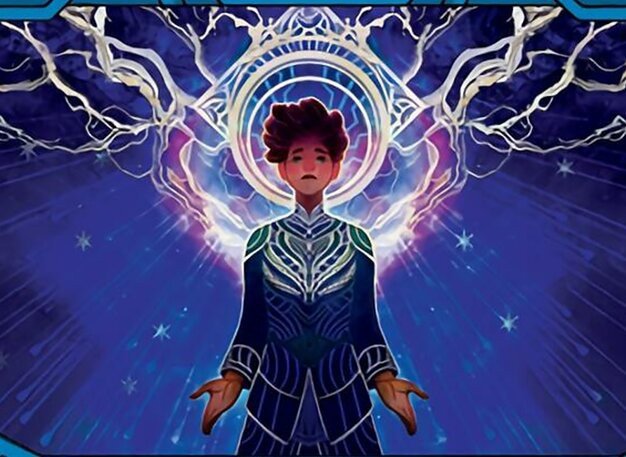




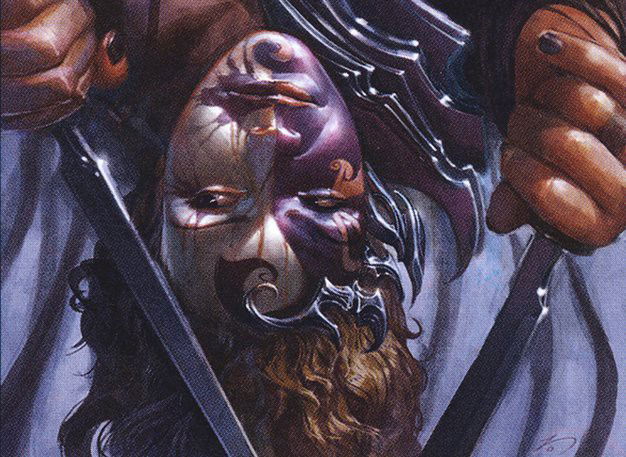



— コメント0
最初にコメントする